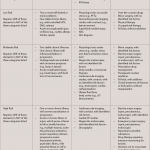Rheumatology is facing a clinician shortage, so attracting the right candidate for your practice may require an aggressive strategy, from recruiting right out of fellowship programs to offering student loan repayment and flexible work schedules…

Subcategories:Billing/CodingEMRsFacilityInsuranceQuality Assurance/ImprovementTechnologyWorkforce

Rheumatology is facing a clinician shortage, so attracting the right candidate for your practice may require an aggressive strategy, from recruiting right out of fellowship programs to offering student loan repayment and flexible work schedules…

All healthcare professionals who work in rheumatology had to start adapting to a new landscape of reporting and documentation on Jan. 1 of this year when the Medicare Access and Children’s Health Insurance Program (CHIP) Reauthorization Act, or MACRA, began. As the changeover continues, the Sunday ARHP session, Your New Role in the Era of…

Changes to reimbursement introduced by the Medicare Access and CHIP Reauthorization Act (MACRA) will affect your Medicare income for 2019. “Rheumatologists generally know that MACRA is up and running,” says Angus Worthing, MD, FACR, FACP, clinical assistant professor of rheumatology at Georgetown University Medical Center and chair of the ACR’s Government Affairs Committee. “Virtually every…

Pediatric rheumatology patients present unique challenges. According to Kyla Driest, MD, MEd, using age and temperament appropriate methods, such as distraction or icing, may help children manage pain and ease anxiety…
This year’s ACR/ARHP Annual Meeting, which takes place Nov. 3–8 in San Diego, features several opportunities to learn more about the ACR’s Rheumatology Informatics System for Effectiveness (RISE) Registry, and the data and tools it offers rheumatologists. For the first time, RISE data will be presented at the Annual Meeting by rheumatologists outside of the ACR’s…
Take the Challenge. ICD-10 Codes R76.1—Raised antibody titer L20.8—Other atopic dermatitis R20.2—Paresthesia of skin R20.1—Hypoesthesia of skin CPT Codes 99358 and 99359 Rationale The Centers for Medicare & Medicaid Services (CMS) typically does not allow separate payment for physician services that do not require face-to-face time with a patient, but as of Jan. 1, 2017,…

In Part 1 of this series, we covered the vital role of medical decision making in determining the final level to bill for a patient encounter. Medical decision making is the key component in coding because it reflects the intensity of the provider’s cognitive labor. This implies that there’s an unseen component involved in the…

Elizabeth Hofheinz, MPH, MEd |
It’s a bit ironic that when injured people are in pain—and their mobility is reduced—they are often expected to travel to a physical therapy clinic. For millions of people, such trips are a burden. In Australia, however, some patients are “letting movement come to them.” Novel research from The University of Melbourne shows that taking…

Steady hands, nerves of steel: The endoscopic transphenoidal hypophysectomy is a delicate neurosurgical procedure. Using a three-dimensional microscope and a powerful magnetic resonance imaging machine to guide them, the surgeon must meticulously dissect the throat tissues, navigate through the palate and the sinuses to reach the base of the skull where the pea-sized master gland,…
A 67-year-old female patient from New York with a long history of fatigue, joint and muscle pain, rash and fevers is scheduled to see the rheumatologist in five days. She is referred to the rheumatologist by her primary care physician (PCP) for possible diagnosis of lupus erythematosus. The patient requested her medical records from her…